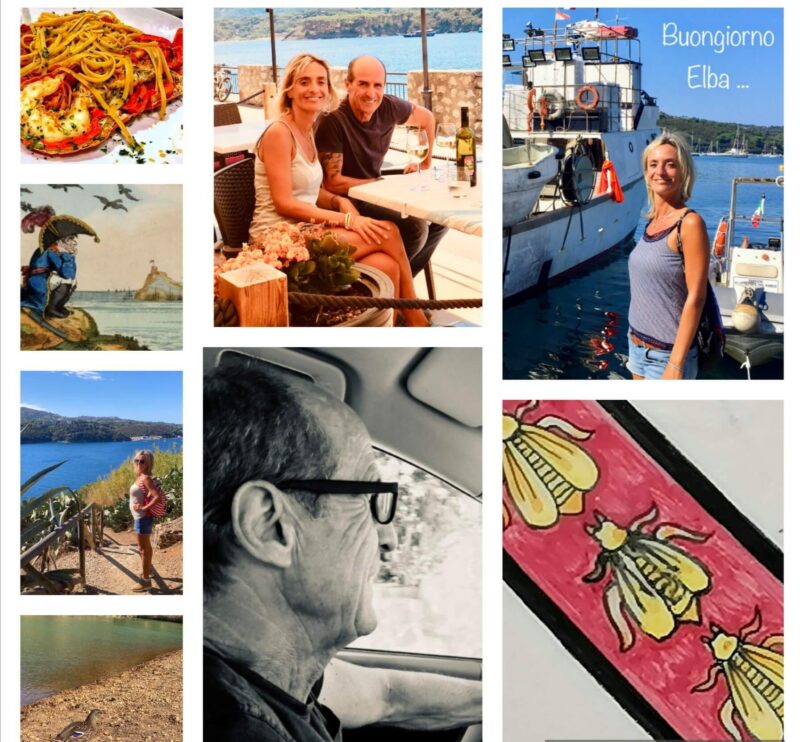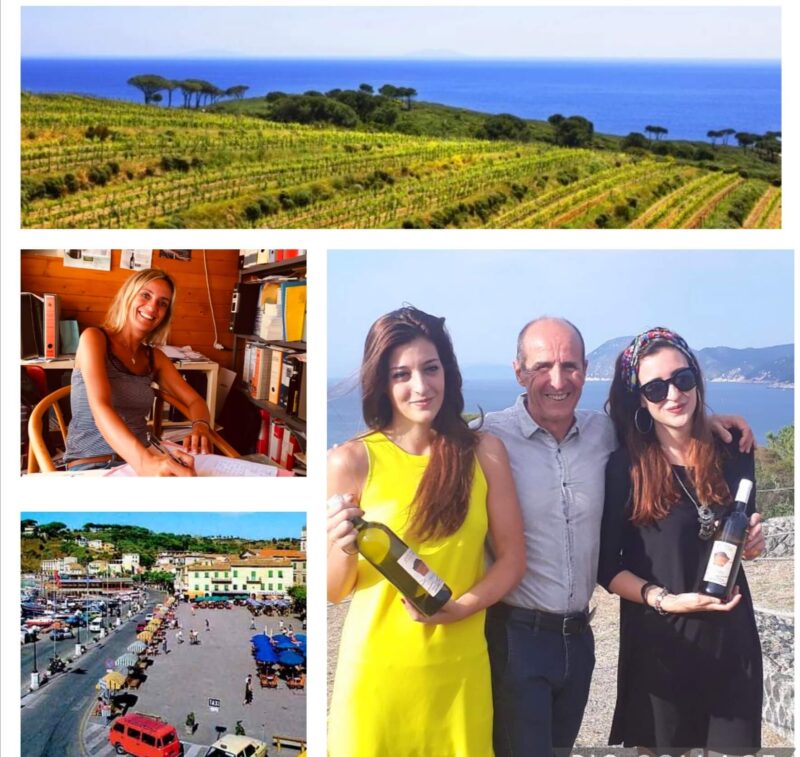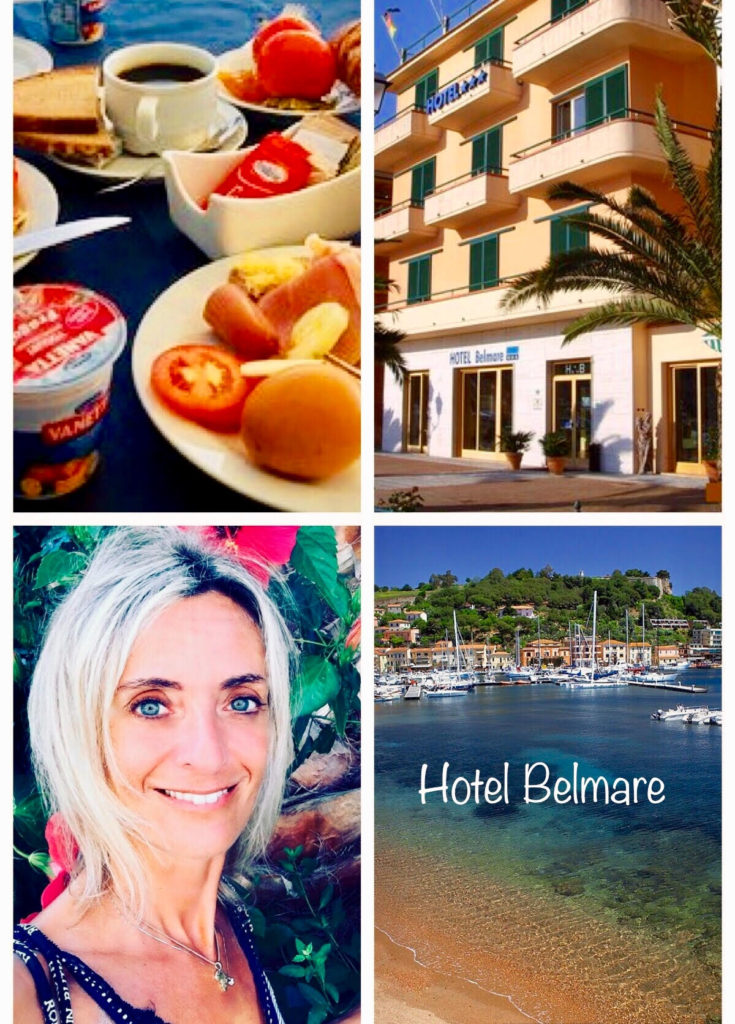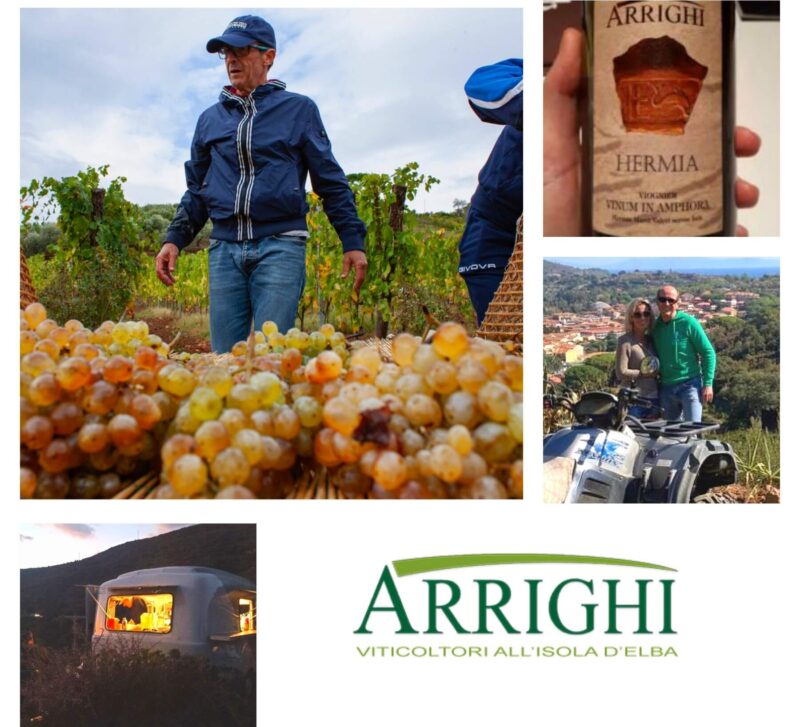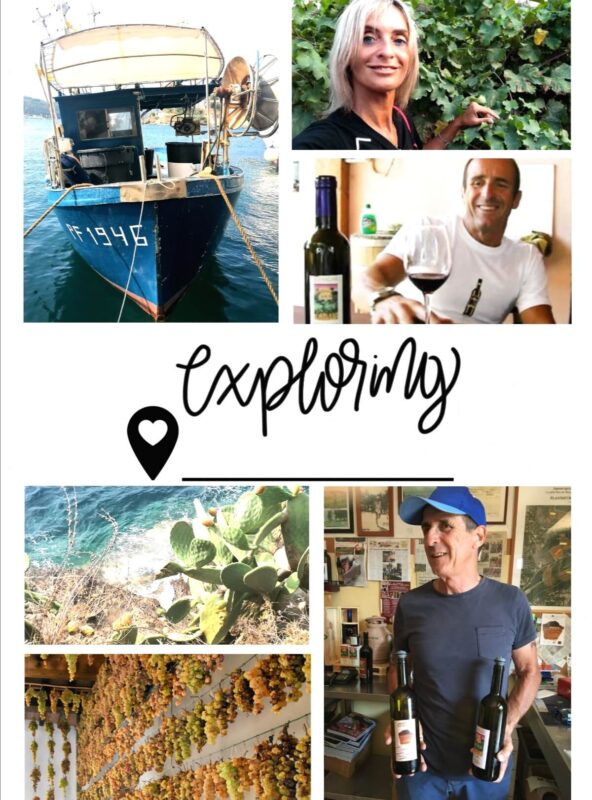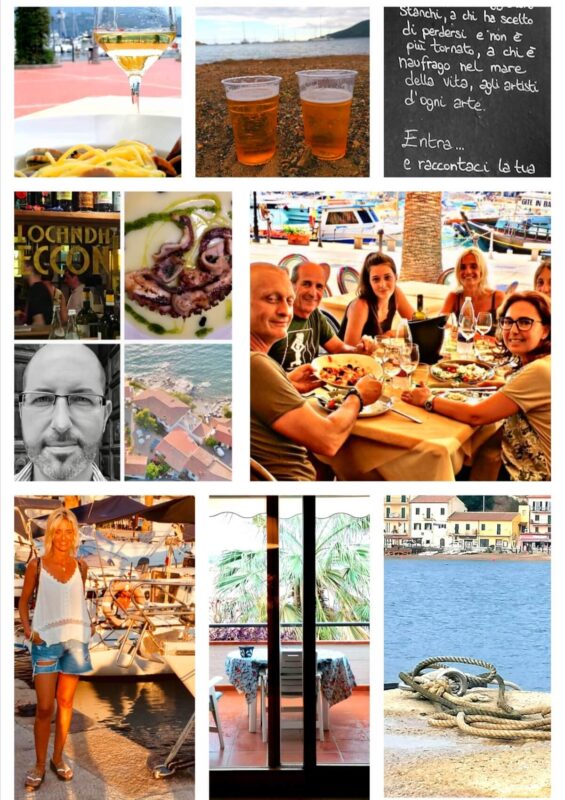“Quando sei felice bevi per festeggiare. Quando sei triste bevi per dimenticare, quando non hai nulla per essere triste o essere felice, bevi per fare accadere qualcosa.”
Charles Bukowski
Bodegas Josè L. Ferrer
Senza dubbio la Bodegas Josè L. Ferrer è un’istituzione divina a Maiorca. Diciamo pure che è la cantina per eccellenza dell’arcipelago delle Baleari. Ancora una volta la curiosità verso il vino mi ha portato a scoprire un territorio immenso. Quello di Maiorca appunto , che vanta un ricco patrimonio culturale, artistico, paesaggistico ed enogastronomico.
Così ho trascorso la mia Pasqua a contemplare , oltre le coste infinite di questo eden spagnolo. Ho sopratutto peregrinato verso l’entroterra. E proprio qui ho avuto un assaggio del meglio dei piatti e dei nettari maiorchini. In questo articolo vi propongo un viaggio enoico nel cuore dell’isola. Un posto che vale la pena di esplorare non solo per le sue baie cristalline e i suoi monumenti. Venite con me e capirete che ci sono vari motivi per regalarvi una vacanza in questo angolo di paradiso.

Bodegas Josè L. Ferrer, un salto a Inca per i cellers
In modo particolare il mio tour ha interessato il lato interno a Nord Ovest di Maiorca. Prima della Bodegas Josè L. Ferrer c’è stata una tappa molto succulenta , quella a Inca. Questo paesino con le sue viuzze ciottolate e le sue chiese circostanti è celebre per il suo cuoio e le sue scarpe. Non è finita qui. La gloria di Inca sono i suoi cellers .
I cellers sono ristoranti caratteristici, che sono ricavati da vecchi depositi dove si faceva il vino in casa. Se volete mangiare e bere maiorchino accomodatevi pure in una di queste osterie . Qualcosa di diverso dai soliti locali più alla moda, assalite dalle orde estive di stranieri in fuga.
In quale celler andare a Inca?
Se non avete idea di quale celler scegliere, vi propongo questo in basso, dove tra l’altro ho beccato i vini della Bodegas Josè L. Ferrer:
- DAYLA – Vins i Tapes in Carrer Bisbe Llompart, 4 : è un celler molto accogliente. Il personale è estremamente gentile. Ti senti come a casa. I ragazzi dello staff mi hanno aperto le porte . Nonostante fossi arrivata in orario quasi di chiusura. Il mio menù ha previsto: un fritto di gamberi rossi spadellati con aglio, pomodorini e peperoni. E una serie di calici di bianchi del posto.
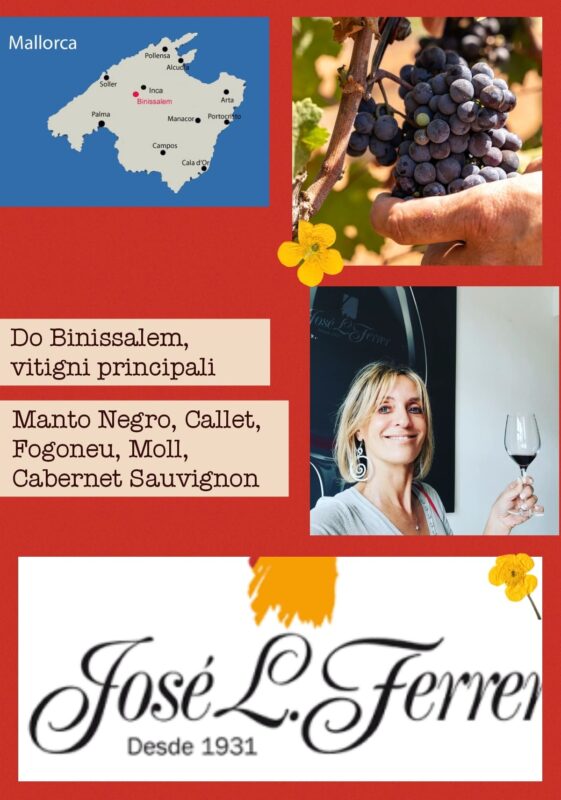
La DO di Benissalem
Così dopo il lauto pranzo a Inca, sono salita in treno per andare a visitare la cantina Bodegas Josè L. Ferrer . Dopo venti minuti mi sono ritrovata a Benisallem. Quella di Benissalem è la prima DO (1990) delle Baleari per la produzione di rossi e rosati.
In questo pueblo interno di Maiorca il re dei vitigni è quello autoctono detto Manto Negro. Esso è anche conosciuto come Callet . Ed è un incrocio tra Callet Cas Concos e Fogoneu. Dato il suo basso contenuto di antociani , la poca acidità e il basso contenuto alcolico, Manto Negro si presta per rossi leggeri. Il suo potenziale aromatico medio fornisce aromi di frutta matura e melograno.
Altri vtigni della DO di Benissalem
A Benisallem ci sono dunque le condizioni ideali per la coltivazione di altri vitigni indigeni e internazionali. Molti dei quali sono gli stessi della Bodegas Josè L. Ferrer:
- Per i rossi : Monastrell, Gorgollassa, Cabernet Sauvignon,Merlot, Syrah, Tempranillo e Pinot Noir;
- Per i bianchi : Petit Corbu, Petit Manseng, Moscatel de Grano Menudo, Giró Ros, Macabeo, Parellada, Chardonnay, Malvasia, Moscato di Alessandria, Riesling e Sauvignon Blanc.
Il Manto Negro,vitgno re della Bodegas Josè L. Ferrer e di Maiorca
Generalmente il Manto Negro è un’uva decisamente da taglio. E per lo più si mesce con il Cabernet Sauvignon, il Syrah o il Tempranillo. Ultimamente però i winemaker maiorchini lo sperimentano in purezza , e con ottimi risultati .
Quella di Benisallem è un’area davvero privilegiata. Infatti è situata al centro di Maiorca . Ed è protetta dalla Serra de Tramuntana. Questo è un sistema montuoso che raggiunge i 1.400 metri di altezza . E protegge i filari dal gelo e dai venti freddi del Nord.

Il Moll , il bianco della DO di Plà i Llevant
Un’ altra DO (1999) è quella di Plá i Llevant a Sud Est di Maiorca. Raggruppa 19 municipalità :
I terreni (altzza massima di 100 metri slm ) qui sono abbastanza fertili e rossi per la presenza di ossido di ferro. Oppure bianchi per il contenuto di argille, carbonato di calcio e magnesio. Il drenaggio è buono e permette una profonda penetrazione delle radici. Senza dubbio importante è la temperatura , che è mite tutto l’anno.
Il vitigno pricipe è quello del Moll o Prensal Blanc . Un’ uva dalla buccia chiara, che genera bianchi fruttati e minerali, con aroma di di mele verde con finale mandorlato . I rosati sono invece agrumati, e gli spumanti quasi eterei.
Maiorca, vino poco ma eccellente
Il vigneto rappresenta una delle colture maggioritarie di Maiorca, che si alterna con mandorli, carrubi, fichi e ulivi. Il sistema di allevamento tradizionale è quello a guyot e cordone speronato. L’intera superficie vitata ammonta a circa 1000/2000 ettari. Non è tanto, per cui si predilige la qualità alla quantità.
Il motivo della poca espansione dei vigneti è dovuto principalmente all’elevato costo della terra. Non c’è da stupirsi, anche perchè Maiorca è diventata una meta immobiliare molto ambita da parte dei norderuopei con i soldi in tasca. Possiamo con certezza affermare che al presente la viticultura è un volano dell’economia maiorchina , che ha davanti un futuro prospero.

Benissalem, un pueblo di meraviglie
Dalla stazione ferroviaria alla Bodega Ferrer con sede a Benisallem c’è una buona mezz’ora di camminata. Durante il tragitto nella cittadina rimarrete ammaliati dalla cura delle abitazioni. Sono tutte lastricate di pietra bianca, basse e adornate di piante. Il silenzio è imperante, interrotto qua e là dal miagolio dei gatti o dalle voci dei bambini che giocano per strada.
A Benisallem , un villaggio di appena 8000 anime, senza dubbio merita una menzione la piazza centrale. In mezzo ad essa si staglia la Chiesa di Santa Maria Robines . Un perfetto esempio di stile barocco del XVIII secolo. Ovviamente questo è il punto di ritrovo di Benisallem, una sorta di salotto cittadino , che è vivo durante tutto l’anno.
Prima di arrivare a destinazione alla Bodega Ferrer , passeggiando per i vicoli ho scovato altre aziende vitivinicole. In tutto se ne contano 70 a Maiorca. Purtroppo erano tutte chiuse per via della festività pasquale.
Storia del vino a Benissalem
Logicamente Benisallem deve la sua fama alla produzione di vino! La tradizione enologica della DO di Benissalem si riflette nei suoi riferimenti storici. L’introduzione della vite risale al 121 d.C. Già nel I secolo d.C., Plinio parla dei vini delle Baleari, confrontandoli con i migliori d’Italia.
Anche durante il periodo della dominazione musulmana, nonostante i divieti del Corano, si faceva il vino a Maiorca. Dopo la conquista, le Corti d’Aragona prima, e poi di Castiglia, favorirono la relativa espansione della coltura della vite, attraverso un regime di permessi di piantagione.
Il vino di Benissalem in letteratura
Troviamo riferimenti ai vini di Binissalem in queste opere letterarie:
- Viaggio alle Isole Baleari e Pitiusas (1807 ) di Grasset Saint-Sauveur;
- Clovis Dardentor (1896 ) di Jules Vernes ;
- Le Baleari descritte con parole e disegni (1880) dell’arciduca Luis Salvador d’Austria.
La coltivazione della vite n generale a Benisallem e a Maiorca ha attraversato momenti di splendore . E counque altri di declino legati alla prefillosserica, alla postfillosserica, alla guerra civile spagnola e al boom turistico degli anni Sessanta. Si ebbe una nuova ripresa alla fine degli anni Ottanta. Da allora, c’è stata una continua crescita del settore.
Zona geografica della DO di Binissalem
La zona geografica della DO Binissalem è costituita dai comuni di:
Con un’estensione di 154,75 km quadrati si tratta di una pianura ovoidale molto fertile , tutta esposta a Sud-Est . Si eleva ad un’altezza compresa tra 70 e 140 m s.l.m. 8 (intorno si possono avere anche alture di 400 metri).
Il terroir delle Baleari
Il terroir delle Baleari è il responsabile di rossi e bianchi unici al mondo, che hanno come tratto distintivo i profumi del Mediterraneo.
I terreni sono ricchi di sedimenti calcarei e di arenarie silicee rosse . Essi danno origine a suoli dai toni bruni o rossastri. Il clima è mite. Al contrario le precipitazioni medie annue diverse in relazione alle stagioni. I monti fanno da scudo ai venti .Mentre la vicinanza al mare è responsabile di una vivace mineralità.
Bodegas José L. Ferrer, una storia di amore per il vino
Appena sono arrivata all’entrata della Bodegas Josè L. Ferrer sono rimasta affascinata dall’architettura moderna e al contempo retrò dell’impresa vitivinicola. Un edificio color ocra molto lineare e semplice . Esso vanta degli esterni e degli interni ampi e luminosi. Questi sono divisi in: sala degustazione, ristorante , laboratorio e barricaia. Ci sono circa 130 ettari di vigneto che circondano lo stabile dove crescono:
Inaugurata nel 2017, quella della Bodegas Josè L. Ferrer è un’attività di famiglia che dura da quattro generazioni. Sin da quando nel 1931 José L. Ferrer , il fondatore, ha messo su la prima pietra. Da allora sono passati circa 85 anni . Nell’arco d quasi un secolo la Bodegas Josè L. Ferrer ha rispettato la tradizione nel fare vino con un occhio attento all’innovazione teconologica.
Bodegas Josè L. Ferrer , perchè sono stati i pionieri del vino a Maiorca?
Bodegas Josè L. Ferrer è un’azienda vitivinicola rappresentativa del patrimonio enoico di Maiorca, e delle Baleari, che ha un passato millenario . Sono stati tra i primi a Maiorca a :
- valorizzare i vitign autoctoni ;
-
adoperare tecniche uniche di coltivazione dell’uva;
-
fare imbottigliamento meccanico ;
-
invecchiare i rossi in botti di rovere di legno ;
- favorire l’uso di sistemi di irrigazione all’avanguardia.
La Bodegas Josè L. Ferrer oggi
Oggi Bodegas Josè L. Ferrer è gestita dal nipote José L. Roses e dai figli, María e Pepe. Tutti quanti seguono le orme del bisnonno. Gli spazi adella tenuta sono grandi. Ognuno di essi è dedicato a tutto quello che serve per l’intero processo di vinificazione, che si svolge secondo criteri rigorosi.
Il riusltato di tanto lavoro è una produzione di circa 800, 000 bottiglie all’anno, che si esportano in Spagna e all’estero. La tenuta offre anche la possibilità di fare dell’ottimo turismo enoico che poggia sulle visite in cantina, sui dei percorsi prenotabili in treno, e su abbinamenti tra vino e specialità della cucina locale.

Bodegas Josè L. Ferrer, quattro vini in degustazione
Quando mi sono entrata alla Bodegas Josè L. Ferrer ho incontrato Sandra Waldmann e Ilhan Kaic Velasco. Lei è un’Italiana esplosiva per metà tedesca. Lui un giovane ragazzo che studia economia . Entrambi fanno parte dello staff dell’accoglienza, che mi hanno guidato nella mia visita alla cantina. Momenti davvero fantastici.
Chiaramente la parte più interessante del mio arrivo alla Bodegas Josè L. Ferrer è stato quello della degustazione . Mi sono seduta su uno sgabello e nella botte fatta a tavolo mi sono state servite quattro etichette formidabili. Vi lascio qualche appunto in merito a ciò che questi vini mi hanno trasmesso. Devo confessarvi che non hanno nulla da invidiare a quelli prodotti in Italia o altrove . Sono stati davvero una piacevole sorpresa, perché associavo lo splendore di Maiorca solamente alle sue acque blu!
Brut e un bianco della Bodegas Josè L. Ferrer
1.Veritas Brut Naure 2022: un brut di 12 gradi fatto con 100% di Moll . Di colore giallo paglierino, le bollicine si espandono fini e in moto costante.
L’aroma è complesso, al naso è come il Verdeho, molto fruttato. Al palato si avvertono note di pera , ananas, e anice. Ha una spiccata acidità, con una punta di amaro che rinfresca;
2. Pedra de Benissalem Blanc 2022 : un bianco di 12, 5 gradi fatto con 100% di Moll . Le uve sono raccolte a mano durante la prima settimana di Agosto, poi sono tenute in fresco a 2° C e sottoposte a una macerazione pellicolare .
La seconda fermentazione avviene a temperature basse in vasche di alluminio. Alla vista è giallo pallido con riflessi verdognoli, trasparente e brillante. Fresco e aromatico, al palato ha note floreali e fruttate, rilevando un’ acidità equilibrata.
Rossi della Bodegas Josè L. Ferrer
3. Veritas Roig 2022 : un rosè di 11, 5 gradi fatto con 100 % di Mantonegro. Il suo è un rosa tenue e pulito, ottenuto con una lieve macerazione sulle bucce.Sembra di annusare una rosa, e della frutta bianca. In bocca è come avere delle fragole, con una punta di limone e arancia. Un vino secco, leggero e un tantino amarognolo, bilanciato e con una persistenza intensa e aromatica;
4. Veritas 2012 : un rosso di 14 gradi fatto con 70 % Mantonegro e 30% di Cabernet . Dal coloro rosso rubino brillante , affina 40 mesi in botte di rovere francese. Al naso sprigiona sentori di pepe e liquirizia, lasciando un pò di amaro. Appena si beve invece risulta più succoso , morbido e setoso. Evidenzia una certa acidità che gli conferisce freschezza.
Bodegas Josè L. Ferrer , un motivo per ritornare a Maiorca
Non è facile descrivervi i vini della Bodegas Josè L. Ferrer , bisogna recarsi in loco e provarli di persona. Ho appreso in modo molto semplice sui vini maiorchini , capendone i loro caratteri distintivi .
Per esempio ho imparato alla Bodegas Josè L. Ferrer che i bianchi maiorchini alla vista hanno un giallo pallido dorato. Essi sono molto aromatici , ricordano l’odore di fiori e frutta delicata. Si fanno notare per la loro freschezza. Al contrario i rosati variano dal rosa pallido all’arancione, sono sfavillanti e limpidi. E infine i vini rossi hanno una grande personalità , specie se in blend, e affinati. Il loro sapore è molto persistente e sono ricchi di tannini.
La mia esperienza alla Bodegas Josè L. Ferrer è stata indimenticabile . E posso garantirvi che vale la pena concedersi una sosta di vino se volerete a Maiorca. Ve lo suggerisco vivamente di staccare presto un biglietto. Resterete abbagliati dalla luce del Mediterraneo, dalla sua bellezza dirompete e dal calore della sua gente. ¡ Buen viaje!
If you like my post, please subscribe to the socials of www.WeLoveitaly.eu :





